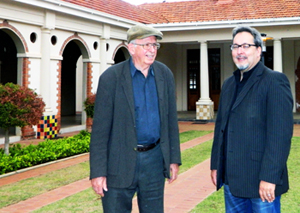
Prof André du Toit (UCT) and Prof Pieter Duvenhage (UFS)
|
Emeritus professor from UCT’s Department of Political Studies, Prof André du Toit, delivered a presentation at the Bloemfontein Campus on 14, 15 and 16 October 2014 respectively. His presentations gave an in-depth exploration of the Postamble as founding text of the South African Truth and Reconciliation Commission (TRC).
This event was hosted by the Institute for Reconciliation and Social Justice, in collaboration with the Department of Philosophy.
Prof Du Toit’s papers were entitled:
• A Need for Truth: Amnesty and the Origins and Consequences of the TRC Process.
• Tracking down a belated and inconclusive amnesty pact: The obscure origins and problematic significance of the 'Postamble' as founding text of the TRC process (Part 1 and 2).
In his presentations he explored how the text of the Postamble came to be written. He also scrutinised the respective contributions of those who were involved in drafting the text. The significance of the Postamble – as it is understood in its historical context – was also a point of discussion.
Prof Du Toit raised some thought-provoking questions during the three days. What is the relation of the amnesty provision of the Postamble with the subsequent TRC amnesty process? How did a text without any particular reference to a truth commission come to function as founding text and discursive framework for the TRC?
He also investigated some of the main problems with the history and significance of the Postamble, as well as its mysterious origins. In addition, Prof Du Toit conducted a critical analysis of a set of newly-identified drafts of the text.
One of Prof Du Toit’s most substantive inquiries, though, was into the question: Was the amnesty provision of the Postamble the product of an underlying amnesty ‘pact’ between the NP government and the ANC?